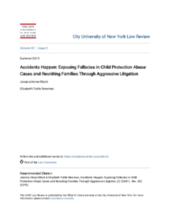Introduction
In New York City, much-needed critical attention has been paid to the racial disproportionality and overreach of the city’s child welfare system, the Administration for Children’s Services (“ACS”), and its conflation of poverty with neglect. The vast majority of child protection cases brought in New York City allege child neglect rather than abuse. This article explores the proportionally smaller category of cases brought with the most severe physical abuse allegations, cases in which ACS is often seen to be most justified in removing and separating children from their families. As The Bronx Defenders Family Defense Practice has developed and evolved over its ten years in existence, we have found that early litigation exposes the fact that, much like elsewhere in child protective law, these serious physical abuse cases are often based on misperceptions and are susceptible to both mistake and overreach.
The mere existence of a fracture, head trauma, or other serious injury in a young child or infant that cannot be explained, even without additional evidence of an intentional act, can trigger civil child abuse allegations, tear apart a family, and stigmatize a parent as an “abuser.” In the context of public defense, where the vast majority of parents represented are low-income people of color, whose parent-child bonds are largely devalued, the severity of an accusation alone can mean long-protracted family separation and, in some cases, the permanent dissolution of a family.
Head trauma and “unexplained fracture” allegations seem medically complicated and unassailable when they include a diagnosis of abuse by a medical professional. A parent defender’s understandable first reaction may be that the case is unwinnable, indefensible, or that a parent faced with these charges may never get their children home. A common response is to resolve the case as expeditiously as possible without challenging the allegations.
In many cases, however, injuries labeled as “unexplained” may be the result of accidents simply unwitnessed by the parents, events not fully understood or believed by medical professionals due to bias, the result of a natural disease process or, in some cases, the injuries may not exist as pled. In our experience in The Bronx Defenders Family Defense Practice, employing aggressive and early litigation in abuse cases, in conjunction with holistic client advocacy by parent advocates and social workers, has more than halved the amount of time families are separated. By immediately demanding proof of abuse or medical evidence that substantiates the abuse allegations, we have in many cases been able to expose that alleged abusive injuries are more likely accidentally caused or related to a natural disease process, even if the accidents are not witnessed. In challenging these cases through immediate and aggressive litigation, we have been able to both achieve quicker reunification between our clients and their children and expose the fallacy that certain injuries in a baby, such as a skull fracture, are necessarily from abuse. We have also found that these cases are winnable, even where a parent can never explain how their child sustained an injury. Early, creative, and aggressive litigation is the key, and this article shares strategies that can be used to win cases, reunify families more quickly, and expose the fallacy that a young child’s “unexplained” injury in some communities is necessarily abusive.
The purpose of the article is to use our experience litigating physical abuse cases in the Bronx to provide practitioners and family defenders both in New York and in other states with ideas and strategies of how to move cases forward for parents and caretakers charged with serious physical abuse of a child. It is our hope that, by challenging these allegations, defense attorneys can expose the misperceptions and overreach of agencies that charge parents with physical abuse based on injuries alone.
Part I includes real Bronx Defenders case examples that demonstrate the shift in how our practice now aggressively litigates abuse cases early and often and how it has changed outcomes for our clients. Part II provides a legal background on some of the most applicable New York City and State child protection processes, statutes, and standards, as well as the racially disproportionate ways in which those statutes, standards, and practices target people of color. Part III provides some of the tools and strategies we have found most useful in pushing reunification, using our cases to demonstrate how emergency hearings, expert witnesses, motion practice, and depositions can expose the fallacy of many abuse cases.

